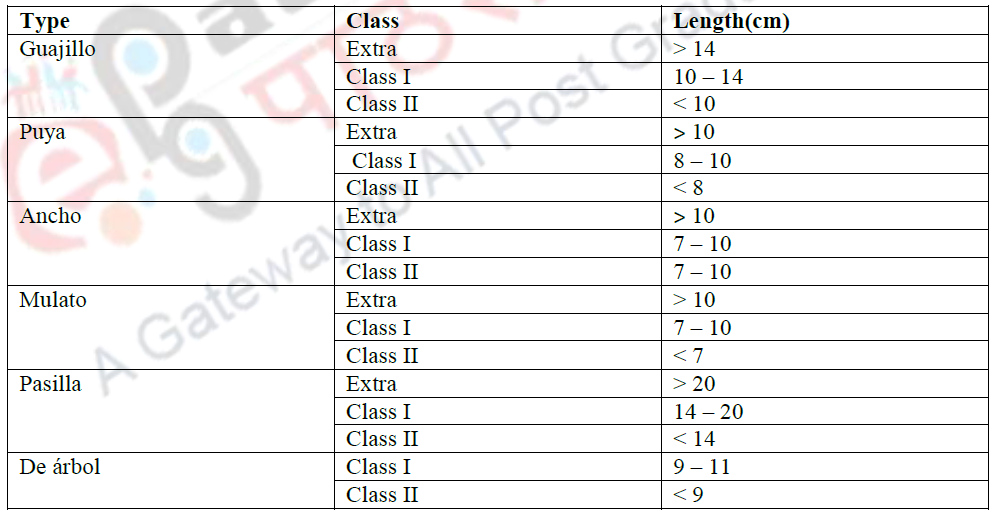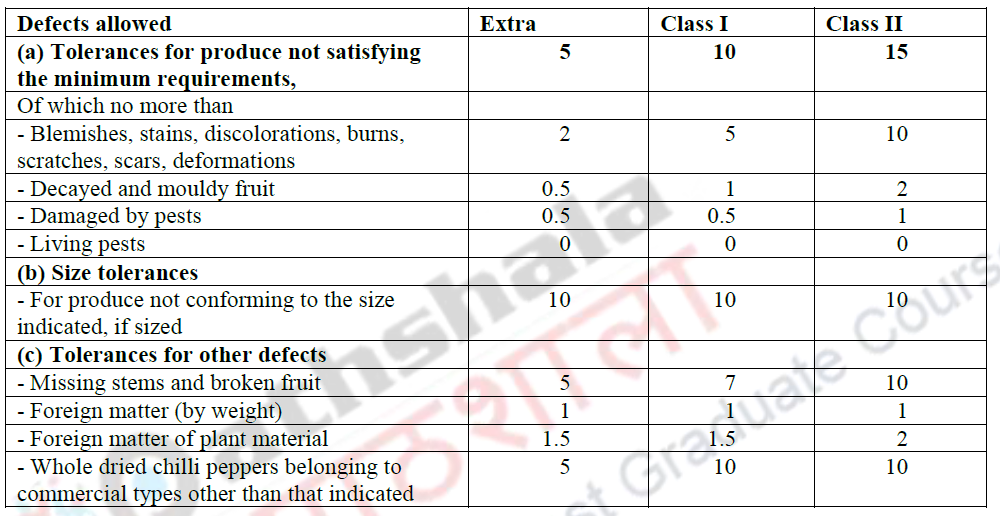15 Chillies: Quality attributes of chillies
Classification of chilli
Whole dried chilli peppers are classified into the following classes:
“Extra” Class, Class I and Class II.
The defects allowed must not affect the general appearance of the produce as regards quality, keeping quality and presentation in the package.
15.1. Chillies: Quality attributes of chillies
The whole dried chilli peppers must display the following characteristics:
- intact; however, slight superficial damage is not considered as a defect.
- sound; produce affected by rotting or deterioration such as to make it unfit for consumption is excluded.
- clean, practically free of any visible foreign matter.
- sufficiently developed and with attached peduncle.
- shape and colour characteristic of chilli types.
- free from living pests whatever their stage of development.
- free from damage caused by pests, including the presence of dead insects and/or mites, their debris or excreta;
- free from blemishes, areas of discolouration or spread stains in pronounced contrast with the rest of the produce affecting in aggregate not more than 5 per cent of the surface of the produce.
- free from mould filaments visible to the naked eye.
- free of abnormal external moisture.
- free of foreign smell and/or taste.
The condition of the whole dried chilli peppers must be such as to enable them:
- to withstand transportation and handling;
- to arrive in satisfactory condition at the place of destination.
15.1.1. Moisture content
Whole dried chilli peppers should have maximum moisture content in accordance with the following table:
15.1.2. Colour
Colour requirement for whole dried chillies is mandatory for the commercial types in accordance with the table below:
15.1.3. Pungency
Commercial types of whole dried chili peppers are characterized by pungency in accordance with the following table:
15.1.3.1. Provisions concerning sizing
Sizing of whole dried chilli peppers is mandatory for “Extra” Class and Class I. Size is determined by the length (measured from the apex of the fruit without considering the peduncle).
15.1.3.2. Provisions concerning tolerances
At all marketing stages, tolerances in respect of quality and size shall be allowed in each lot for produce not satisfying the minimum requirements of the class indicated.
Quality tolerances
15.2. Commonly used terminology for whole dried chillies:
15.2.1. Ancho chilli:
Fruits have a conical shape, with sizes that vary in longitude and width. The base of the insertion of the peduncle can be flat or with indented shoulders; the body is generally flattened; the apex is pointed or round, and presents from two to four loculi. Its production as dry pepper is achieved mostly by artificially dehydrating the fruits, although a large part of this type of chilli is commercialized fresh.
15.2.2. De árbol chilli:
Small fruits, with a uniform intense or dark red coloration, with no discoloration, cylindrical, with a shape prominently long and pointed, characterized by their high pungency.
15.2.3. Guajillo chilli:
Also known as mirasol, generally, it is long, with a sharp end; its body is cylindrical, smooth and with slight undulations. It has two to three locules; its position is hanging, even when there are some variants with erected fruits. This type of chilli is moderately pungent and its commercial production is in its majority dried in the plant in a natural way.
15.2.4. Mulato chilli:
With a shape similar to the ancho chilli, it has the same variation in the growth habit and shape of the fruit, but generally less pungent. The basic difference with ancho chilli is the colour, which is dark brown when ripe and blackish brown once it is dehydrated.
15.2.5. Pasilla chilli:
Fruit with a long undulated body that ends in a flat or pointed apex; it presents from two to three loculi. Its production is mainly destined for dehydrating, with a small amount consumed fresh.
15.2.6. Puya chilli:
It is an elongated fruit, medium size, smaller than mirasol chillies and bigger than de árbol chillies, with a uniform intense red or dark red colour, with no discoloration. Its production is dehydrated mainly in a natural way in the plant before use in salsas. After the de árbol chilli, it is considered highly pungent.




